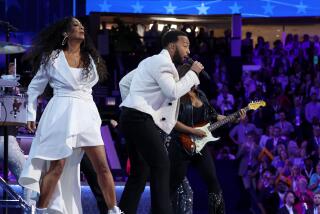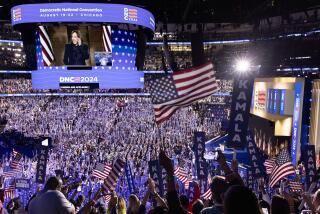Nostalgia for Conventions That Never Were
- Share via
BOSTON — The 2000 national political conventions elicited little more than a national yawn. Most Americans ignored the festivities, while the press and pundits dismissed the calculated, made-for-TV events as “infomercials.” Instead they longed for the Olympian confrontations and dramatic surprises of yesteryear: 1844, when the first dark horse, James Knox Polk, galloped out of the shadows and into the White House; 1896, when the silver-tongued William Jennings Bryan electrified his party and wrested the nomination from more senior rivals; 1932, when Franklin D. Roosevelt appeared in person and promised a “New Deal for the American people”; and 1968, when anti-war protesters and Mayor Richard J. Daley’s police battled on the streets of Chicago.
Today’s critics mourn the loss of inspired oratory, spontaneous audiences and serious debate. But, in truth, U.S. political conventions rarely featured any of these. Nearly all have been tedious affairs, full of inconsequential, long-winded speeches, parochial disputes and stage-managed demonstrations.
Most convention addresses have sounded the same mind-numbing, self-aggrandizing themes, barely exciting even the delegates in the hall. “The combat of rhetoricians and roosters during the long, hot and weary hours of the night was depressingly typical,” H.L. Mencken accurately reported in 1932. “The show was almost completely idiotic, with now and then a more or less rational speech to relieve it.”
In 1876, the parties institutionalized the practice of formal nominations for each contender. Nominating speeches consumed hours, often days; after a long speech formally placed each candidate’s name before the convention, two, three, sometimes as many as six separate seconding speeches followed.
The process soon grew absurd. At the 1884 Democratic Convention, angry Tammany Hall regulars made two of the seconding speeches for New York Gov. Grover Cleveland and denounced their own candidate. Indiana Sen. Thomas A. Hendricks, one of Cleveland’s principal opponents, actually nominated another contender, and then spent more time highlighting his own attributes than praising the man he ostensibly supported.
Because the big prizes--the nominations for president and vice president--remained at stake during these early conventions, issues played an even smaller role than today. Certainly, the most pressing national issues sometimes divided the parties--slavery before the Civil War, the gold standard in the late 19th century, civil rights in recent years. But for more than a century, conventions devoted far more attention to arcane debates over rules and credentials. At the 1876 GOP convention in Cincinnati, the nomination fight came down to a lengthy procedural scuffle over the so-called unit rule--the practice of states agreeing in advance to cast all their votes for one candidate.
When three Pennsylvania delegates wished to cast dissenting ballots, the chairman decided to count their votes, sparking an endless argument. After long debate, and four separate votes, the convention finally upheld the chair’s ruling.
The 1924 Democratic Convention dragged on for 17 days. Deadlocked between two candidates, the delegates spent most of that hot summer in fruitless disputes over rule changes--arguing whether to invite the contenders to a special executive session, to drop the lowest vote-getter after each ballot, even to adjourn for two weeks and reconvene in Kansas City.
Nor did politicians need the glare of television to grandstand before the hometown crowd. The proceedings--in stifling, foul-smelling halls without air conditioning--lasted so long because delegates insisted on nominating numerous candidates, not just the serious contenders for president and vice president. States typically backed their “favorite sons,” making stupefying addresses to extol their virtues or just to hog time in the spotlight. In 1880, the Republicans took 36 ballots and two extra days to nominate James A. Garfield for president. A routine motion to make it unanimous required 11 additional speeches!
The arrival of mass media only intensified the orgy of self-promotion. In 1932, the Democrats postponed the evening session on what should have been nomination night to get a radio hook-up. In the words of H.L. Mencken, “every fourth-rate local leader tried for a crack at the microphone. More than once delegates objected that the Niagara of bilge was killing them,” but the ordeal continued until nine candidates were nominated, and each seconded numerous times.
Still, the most familiar criticism of contemporary conventions is their rigid scripts--the complete lack of spontaneity and news. Today, no one can stampede the convention with an emotional appearance as Bryan did with his Cross of Gold speech in 1896. Or block such a rash decision as opponents of House Speaker (and perennial candidate) James G. Blaine did after an inspiring speech, when they broke the basement gas pipes, forcing an early recess as the gaslights in the auditorium failed. Now, journalists receive schedules from party managers with plans for “five minutes of balloons and spontaneous cheers.”
But 19th-century bosses managed reactions on the floor even more carefully than today’s political consultants. “Campaign managers of each aspirant,” one turn-of-the-century journalist reported, procured tempestuous audience reactions “by means of a paid claque, judiciously distributed over the enormous hall.” At key moments, they “jump up on seats and break into cheers and other less articulate convulsions.” At the 1912 GOP gathering, party regulars supporting incumbent President William Howard Taft won a credentials fight with insurgents supporting ex-President Theodore Roosevelt. The party bosses prevented a show of support for Roosevelt by filling the galleries with shills: On cue, the claque cheered the ousting of Roosevelt supporters with a deafening shuffling, choo-choo noise.
To be sure, the national conventions have produced a handful of memorable speeches. In 1884, Col. Robert Ingersoll famously dubbed Blaine the “plumed knight.” Forty years later, a young Franklin D. Roosevelt stole the show when he celebrated New York Gov. Al Smith as the “happy warrior.” Minneapolis Mayor Hubert H. Humphrey built a national reputation when he dared the 1948 Democratic convention to escape the darkness of state’s rights into the bright sun of civil rights. But those perorations earned their fame because they were so unusual.
Conventions of the past offered little more excitement, and few more unscripted surprises, than this year’s meetings in Los Angeles and Philadelphia. How, then, do we account for the misplaced nostalgia? The mooning for a lost past reflects the powerful influence the conventions of the 1960s exert on our historical imagination. Those quadrennial meetings, overwhelmed by deep political divisions and captured on network television, formed the model for most contemporary commentators. They recall 1964, when conservatives took over the GOP in San Francisco, engaging in a public display of disaffection with the old-line Wall Street Republicans. Meanwhile, in Atlantic City, a bitter struggle transformed the Democrats from the party of the Old South to the champions of civil rights. And, in 1968, the Democratic Convention practically dissolved into civil war, both inside the hall and on the city streets.
But those conventions proved as exceptional as the tumultuous times that produced them. The Republicans’ show of diversity in Philadelphia, the Democrats’ homage to John F. Kennedy in Los Angeles, proved no less boring and no less calculated than most of their predecessors. The primary elections that preceded them offered more genuine news and far more substantial discussion of issues than conventions ever did. There never were glory days of political conventions; Americans should not yearn for them. *
More to Read
Get the L.A. Times Politics newsletter
Deeply reported insights into legislation, politics and policy from Sacramento, Washington and beyond. In your inbox three times per week.
You may occasionally receive promotional content from the Los Angeles Times.










